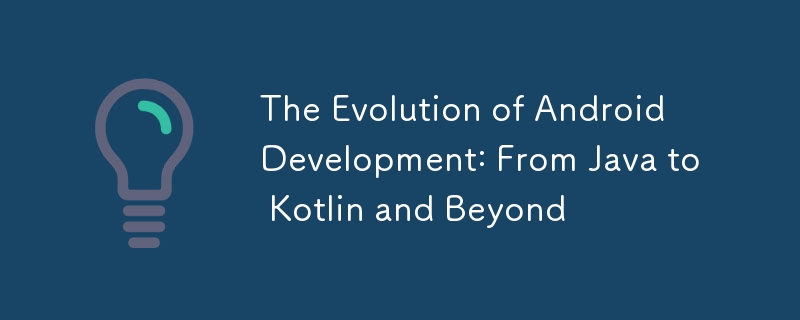

In the ever-evolving world of technology, few platforms have undergone as significant a transformation as Android development. Since its inception, Android has revolutionized the mobile industry, enabling developers to create apps that cater to billions of users worldwide. However, the journey of Android development has been anything but static. From the early days of Java to the modern adoption of Kotlin, and now moving towards even more advanced paradigms, Android development has continuously evolved to meet the needs of developers and users alike.
When Android was first introduced by Google in 2008, Java was the primary language for building Android apps. Java, a mature and well-established language, provided a robust and versatile platform for developers to create feature-rich mobile applications. With its object-oriented structure, extensive libraries, and widespread community support, Java quickly became synonymous with Android development.
However, despite its strengths, Java also had its limitations. The verbosity of the language, the frequent need for boilerplate code, and the challenges in managing null references were some of the pain points developers encountered. As the Android platform grew in complexity, the need for a more modern and efficient language became increasingly apparent.
In 2017, Google announced Kotlin as an official language for Android development, marking a significant milestone in the evolution of the platform. Developed by JetBrains, the creators of IntelliJ IDEA, Kotlin was designed to be fully interoperable with Java while offering a more concise and expressive syntax. This announcement was met with enthusiasm from the developer community, as Kotlin addressed many of the pain points associated with Java.
Kotlin brought several key advantages to Android development:
Conciseness: Kotlin's syntax is more concise than Java, allowing developers to write less code while achieving the same functionality. This not only reduces the potential for errors but also improves code readability and maintainability.
Null Safety: One of the most common sources of bugs in Java was null pointer exceptions. Kotlin introduced null safety as a first-class feature, helping developers avoid these issues by design.
Interoperability: Kotlin is fully interoperable with Java, meaning that developers could gradually adopt Kotlin in existing projects without having to rewrite the entire codebase. This smooth transition made it easier for teams to embrace the new language.
Coroutines: Kotlin introduced coroutines, a powerful tool for managing asynchronous code. Coroutines simplify the process of handling tasks such as network requests, making code more intuitive and easier to manage.
Support and Community: Kotlin has quickly gained a strong following in the developer community, leading to a wealth of libraries, tools, and resources. Google's official support for Kotlin also meant that developers could rely on continued updates and improvements.
While Kotlin has become the preferred language for Android development, the evolution of the platform is far from over. The Android ecosystem continues to advance, driven by emerging technologies and the ever-changing needs of users.
Jetpack Compose: Jetpack Compose is Google's modern toolkit for building native Android UIs. It offers a declarative approach to UI development, enabling developers to create intuitive and responsive interfaces with less code. Jetpack Compose is closely integrated with Kotlin, allowing for a seamless development experience.
Multiplatform Development: With the rise of Kotlin Multiplatform, developers can now share code across different platforms, including Android, iOS, and the web. This approach reduces duplication and allows for a more consistent user experience across devices.
AI and Machine Learning: As AI and machine learning become increasingly integral to mobile apps, Android development is evolving to incorporate these technologies. Google provides tools like TensorFlow Lite and ML Kit to help developers build smarter, more personalized applications.
Foldable Devices and 5G: The advent of foldable devices and 5G connectivity is pushing the boundaries of what mobile apps can do. Android development is adapting to these changes, with new guidelines and tools to support flexible UIs and high-performance applications.
Improved Development Environments: Tools like Android Studio continue to evolve, offering better performance, new features, and improved support for modern development practices. With the integration of Kotlin and Jetpack Compose, the development environment has never been more powerful or intuitive.
The evolution of Android development from Java to Kotlin and beyond is a testament to the platform's adaptability and resilience. Kotlin has empowered developers to write more efficient, readable, and maintainable code, while the ongoing advancements in the Android ecosystem promise an exciting future for mobile development. As we look ahead, the combination of modern languages, tools, and technologies will continue to shape the way we build apps, ensuring that Android remains at the forefront of innovation.
Whether you're a seasoned Android developer or just starting, understanding this evolution is crucial to staying ahead in the ever-changing landscape of mobile development. The journey from Java to Kotlin has been transformative, and as we move beyond, the possibilities for what can be achieved with Android are limitless.
Das obige ist der detaillierte Inhalt vonThe Evolution of Android Development: From Java to Kotlin and Beyond. Für weitere Informationen folgen Sie bitte anderen verwandten Artikeln auf der PHP chinesischen Website!




